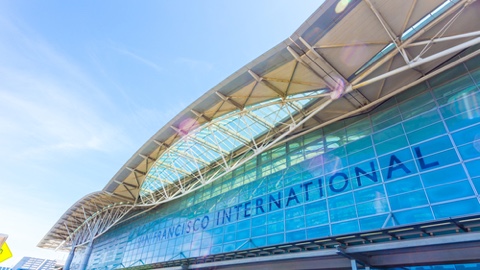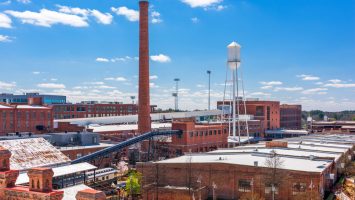
Brandon Tinianov, VP Industry Strategy, View, Inc. shares details about the company’s winning Smart 50 Awards project at San Francisco International Airport (SFO). It’s just the beginning! Learn more about what they did at SFO and what’s ahead.
The SFO Terminal 1 redevelopment project is a one million-square-foot terminal renovation and rebuild. This is the newest addition to SFO as part of a 10-year renovation schedule. SFO is famous for being cutting edge in their terminal design, having some of the most successful terminals in the world. This project’s goals include net zero energy usage and premium passenger experience. Pursuant to both of these objectives, they chose a 14-foot tall, all-glass façade with View’s dynamic glass for the entire boarding area, plus portions of the land-side façade.
The airport chose dynamic glass to deliver superior occupant comfort, passenger experience, and terminal flexibility for future developments and space reprogramming. During the design and analysis phase, there was full life cycle analysis performed by Autocase. Their Triple Bottom Line Cost Benefit Analysis (TBL-CBA) calculated the full lifetime economic and non-economic benefits of the dynamic glass and concluded that using it would deliver benefits more than twice its initial cost based on energy savings, occupant comfort and employee performance. The resulting design will be one of the largest dynamic glass installations in an airport in the world.
Q: What does the term smart city mean to you, and how does your project contribute to a larger smart city vision?
A: In a traditional city, none of the constituent resources or data flows don’t connect to, or react to each other. Energy doesn’t speak to water or transportation; and buildings owned by separate firms don’t share resources (energy, heat, space) or data. A smart city is where all of these resources and information flows are connected to each other and optimized to minimize energy usage, maximize resource utilization, and improve the occupant experience and movement through the city. Simply stated, smart cities holistically plan and manage both resources and people. I feel that an airport is in essence, a smaller scale smart city. Today’s major airports simultaneously manage their water, energy, air, physical infrastructure, IT, and passenger flow, all under the same roof. The lessens they learn at a scale of millions of passengers per year are directly applicable to the problems major cities face today.
Q: Why is the implementation of your project transformational in our current society?
A: Though it’s not widely acknowledged by the public, airports have long been first movers in terms of new technologies in the built environment, especially associated with occupant experience. As smart cities see widespread adoption, they’ll pull technology best practices from airports. Airports have found that dynamic glass can reduce the energy requirements of a terminal while simultaneously connecting occupants to the outdoors. They become more comfortable and relaxed, and as a result, often spend more. These same benefits – energy savings, occupant comfort, smart skin, directly benefit smart cities at scale.
Q: What advice did you receive along the way that helped you complete your winning project?
A: The best advice that we received was to understand the airport’s short and long-term priorities and values, especially with regard to sustainability and smart infrastructure, and passenger experience.
The SFO project team feels that when this project completes in seven years, it needs to ‘feel modern and new’. I think that they’ve accomplished that. They’ve stuck to their core values that led to a very energy efficient project that feels both comfortable and expansive to the passenger.
Q: What advice would you give a city community or a solution provider looking to implement at a municipal-level project?
A: The best projects, whether at a district or a city scale, is one that looks at both the economic and the non-economic benefits of the target technologies. This pairing drove the airport project to ultimate success. They will add all kinds of non-economic amenities or technologies that ultimately drive either higher revenue or improved passenger experience and more traffic through the space. I would advise they look at the non-economic benefits if they’re added to the economic benefits.
Q: What does it mean to you to win the Smart 50 awards?
A: It validates our belief that we really have a solid footing in a future where cities are interconnected by data, resources and occupant experience.
Q: Do you think that there will ever be a time when we look forward to going to the airport?
A: Absolutely. Those experiences exist some airports event today. For example, I enjoy the main gathering area at the SeaTac International, the Seattle airport, where live music often performs in front of a 40-foot glass wall looks over Mount Rainier. It is a wonderful place to spend time as you watch planes take off and land and I spend an extra half-hour there every time I’m in town. There’s no reason that every airport can’t create that special experience and reason to visit in the future.
Q: Are there any other airports where View Dynamic Glass is installed, besides SFO?
A: It’s early days for dynamic glass in airports, but we’re seeing great traction. We’ve been installed in the Meacham International Airport right outside of the Dallas-Fort Worth area. That’s been a very successful installation for us. Charlotte-Douglas International Airport in North Carolina just completed the installation in the Concourse A expansion, and we’re also being installed at Boston’s Logan International Airport Terminal B renovation. Finally, dynamic glass is in both the Delta Crown Room and Alaska Airlines Boardroom at SeaTac airport.
Q: Why is glass, smart or not, important for airports?
A: At their basic level, airports are the launching off points for far off destinations. As a result, they need to deliver a clear view of the planes, their takeoffs, and their landings to waiting passengers. Views are critical to the airport experience. However, these massive windows struggle to manage heat flow and glare into the boarding area with waiting passengers. High performance glass, ideally smart glass, manages heat and glare, while delivering an unobstructed view of the incoming planes.


